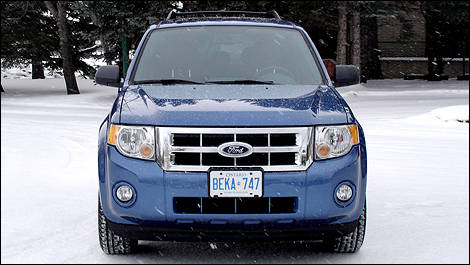With the Escape, Ford seems to feel that if some is good, more is better.
Mind you they did limit themselves to the good types of more. At the top of the list is more fuel economy. With the new 2.5-litre engine (last year it was 2.3 litres), fuel economy improves in both the city and highway tests. It may not seem like much to you, but a 6.5% improvement in town is impressive.
If you don't want to save $0.60 on every $10.00 you spend on fuel, let me know, I'll take it!!
Engine
To get this "saving", engineers did more than increase displacement. The DOHC inline four now has continuously variable valve timing on the intake cam. Ford also added ETC, or Electronic Throttle Control, and eliminated the mechanical throttle linkage.
This small change allows for precise throttle movement and much closer calibration of the air/fuel mixture and throttle position. When you put all the changes together, horsepower comes up to 171 and peak torque becomes 171 lb-ft. These changes also make the four-cylinder Escape about one second quicker to 100 km/h.
Transmission
The base transmission may still be a five-speed manual, but next on the list of more is the automatic transmission. Last year's four-speed automatic has been replaced with a six-speed. This change is considerably more than the addition of two gears. All six ratios have been selected to provide optimal performance and contribute to both improved acceleration and fuel economy.
Economy Improvements
There is another category of fuel improvements that revolve around non-drivetrain components. Ford engineers have been hard at work here, too. Working in conjunction with Ford, Michelin has developed low-rolling resistance tires. These tires are lighter than average and utilize the latest tread designs to keep noise to a minimum.
Power steering has gone electric (known as EPAS for Electric Power Assist Steering) for 2009, freeing up about 10 horsepower to be put to use elsewhere. Changes to the body aerodynamics include a new front spoiler and the first rear tire spoilers to be used on a Ford SUV.
Ride and Handling
I didn't think that Ford would be able to improve ride characteristics, given the use of low-rolling resistance tires, but they did. For 2009, spring rates have been fine-tuned, shock valving has been altered and a new rear stabilizer bar has been added. These changes are all subtle and so is the improvement in ride quality. You just about need to take an old Escape down the same road as a new one to really notice the extra comfort.
Mind you they did limit themselves to the good types of more. At the top of the list is more fuel economy. With the new 2.5-litre engine (last year it was 2.3 litres), fuel economy improves in both the city and highway tests. It may not seem like much to you, but a 6.5% improvement in town is impressive.
If you don't want to save $0.60 on every $10.00 you spend on fuel, let me know, I'll take it!!
 |
| With the new 2.5-litre engine, fuel economy improves in both the city and highway tests. |
Engine
To get this "saving", engineers did more than increase displacement. The DOHC inline four now has continuously variable valve timing on the intake cam. Ford also added ETC, or Electronic Throttle Control, and eliminated the mechanical throttle linkage.
This small change allows for precise throttle movement and much closer calibration of the air/fuel mixture and throttle position. When you put all the changes together, horsepower comes up to 171 and peak torque becomes 171 lb-ft. These changes also make the four-cylinder Escape about one second quicker to 100 km/h.
Transmission
The base transmission may still be a five-speed manual, but next on the list of more is the automatic transmission. Last year's four-speed automatic has been replaced with a six-speed. This change is considerably more than the addition of two gears. All six ratios have been selected to provide optimal performance and contribute to both improved acceleration and fuel economy.
Economy Improvements
There is another category of fuel improvements that revolve around non-drivetrain components. Ford engineers have been hard at work here, too. Working in conjunction with Ford, Michelin has developed low-rolling resistance tires. These tires are lighter than average and utilize the latest tread designs to keep noise to a minimum.
Power steering has gone electric (known as EPAS for Electric Power Assist Steering) for 2009, freeing up about 10 horsepower to be put to use elsewhere. Changes to the body aerodynamics include a new front spoiler and the first rear tire spoilers to be used on a Ford SUV.
Ride and Handling
I didn't think that Ford would be able to improve ride characteristics, given the use of low-rolling resistance tires, but they did. For 2009, spring rates have been fine-tuned, shock valving has been altered and a new rear stabilizer bar has been added. These changes are all subtle and so is the improvement in ride quality. You just about need to take an old Escape down the same road as a new one to really notice the extra comfort.
 |
| Working in conjunction with Ford, Michelin has developed low-rolling resistance tires. |




